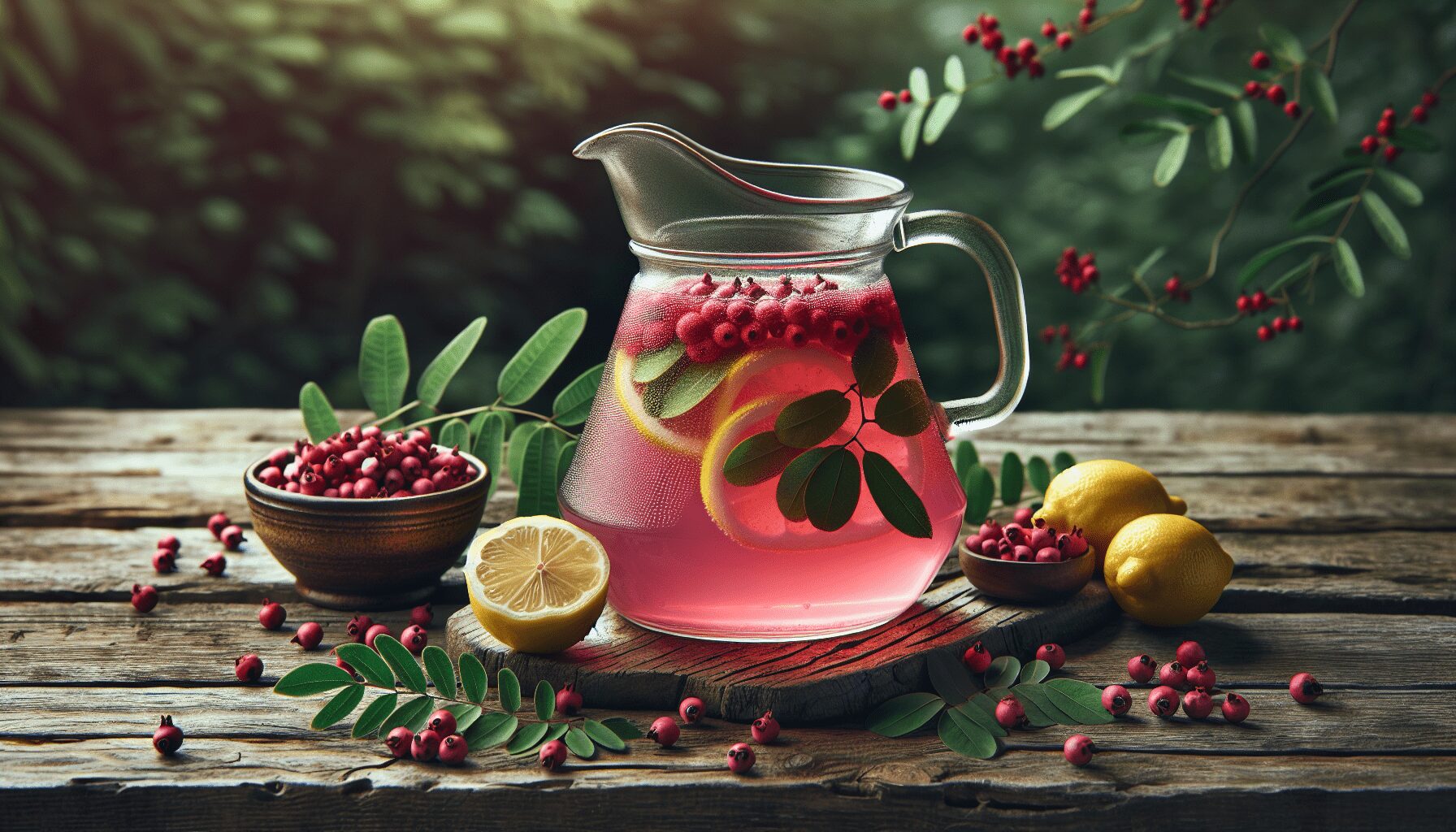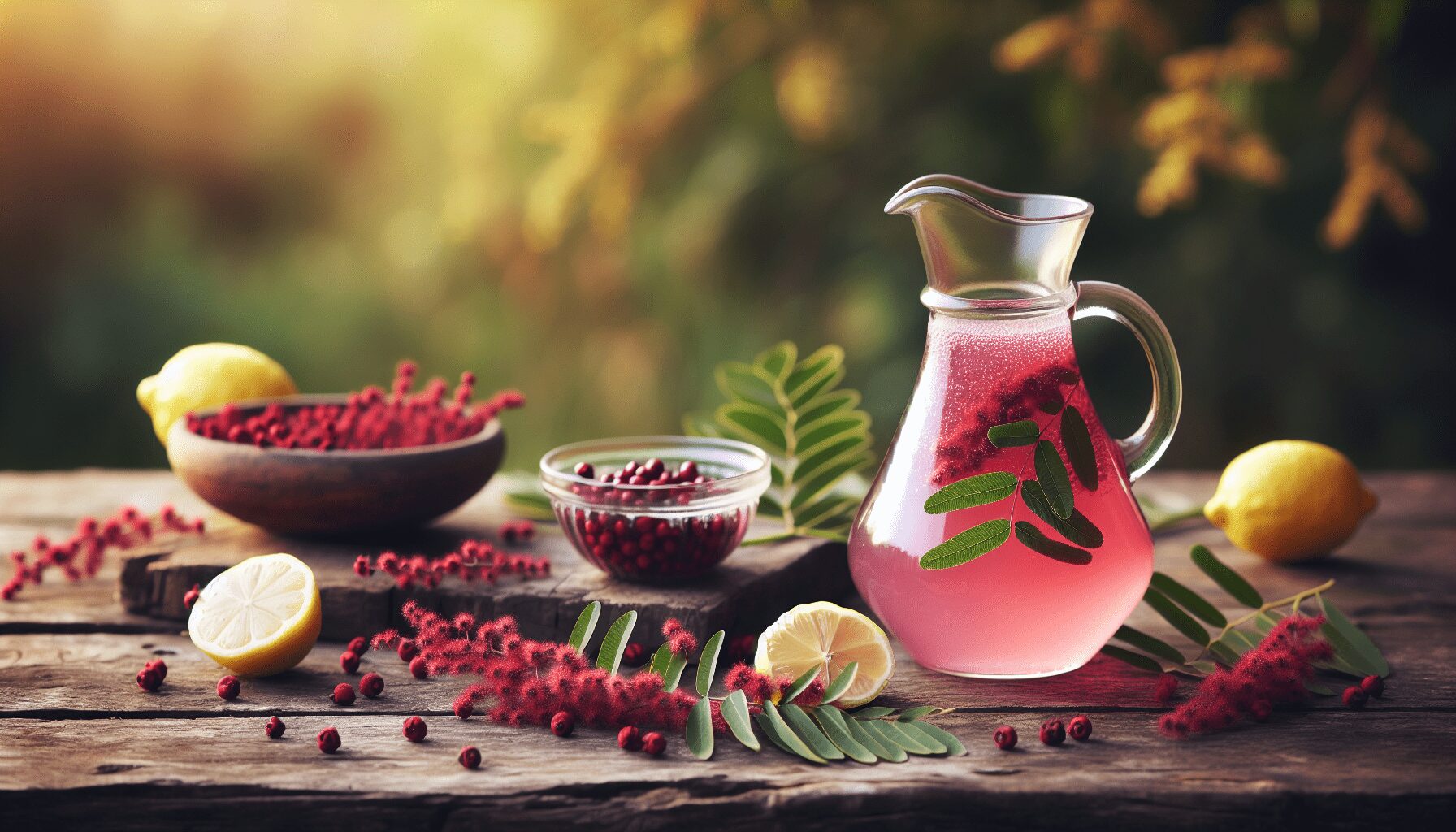Imagine enjoying a refreshing glass of lemonade on a sweltering summer day, except this time, it carries a unique, tangy twist. “How to Make Sumac Lemonade: Foraging Sumac Spice” is all about adding a touch of the wild to your traditional beverage and making it accessible, even if you live in a region where lemon trees don’t thrive.
In this guide, you will learn how to identify and forage for staghorn sumac, a plant commonly found across North America, and transform its vibrant red berries into a delightful summer drink. The steps outlined cover everything from harvesting the sumac berries at the perfect time to blending them with fresh ingredients like blueberries and mint for a truly invigorating experience.

This image is property of i.ytimg.com.
Choosing the Right Sumac
Identifying Staghorn Sumac
When you’re foraging for sumac, it’s essential to identify the right kind. Staghorn sumac (Rhus typhina) is your target. This robust plant is easy to recognize by its large clusters of fuzzy, red berries that grow on top of tall, woody stems. The leaves are compound, comprising several pairs of leaflets, which turn a beautiful red-orange in the fall. This plant thrives in New England, Canada, and even as far south as Georgia and west to Utah. Knowing how to distinguish staghorn sumac ensures you collect the right plant for your lemonade.
Differentiating Between Edible and Poisonous Sumac
It’s crucial to differentiate edible sumac from its toxic relative, poison sumac (Toxicodendron vernix). Poison sumac has white or grayish berries that hang down and grows predominantly in wet, swampy areas, unlike the dry, open habitats favored by staghorn sumac. Additionally, poison sumac’s leaves have fewer, wider-spaced leaflets and lack the vibrant red coloration of staghorn sumac’s berries. Being aware of these differences will prevent any unpleasant encounters.
Optimal Harvesting Time
The best time to harvest sumac berries is when the clusters, or drupes, turn deep red and are fully ripe, usually from late summer to early fall. It’s advisable to wait for a period of dry weather, as rain can wash away the hairy coating on the berries that contains most of the flavor. Harvesting during dry conditions will ensure the berries retain their tart, lemony taste, enhancing your sumac lemonade’s flavor.
Foraging Sumac: Where and How
Ideal Locations for Foraging
Look for staghorn sumac growing in open fields, along roadsides, and at the edges of forests. These plants prefer sunny environments and well-drained soil. Urban foraging can be just as rewarding, but be cautious of areas that may have been exposed to pollutants. National parks and nature reserves can be excellent places to find clean and healthy sumac.
Tools and Equipment Needed
Foraging sumac doesn’t require elaborate equipment. A good pair of pruning shears is handy for cutting the clusters of berries from high branches. Carry a basket or a canvas bag to collect and transport your harvest. Wearing gloves can protect your hands from the tiny hairs on the berries, which can sometimes be irritating.
Sustainable Harvesting Practices
Always practice sustainable foraging to maintain healthy wild populations. Only collect a portion of the available berries, leaving enough for the plant to reproduce and for wildlife that relies on them. Be respectful of the environment, and avoid trampling on surrounding vegetation to preserve the ecosystem’s integrity.
Harvesting Sumac Berries
Spotting Ripe Berries
Ripe sumac berries are a striking, deep red and have a fuzzy texture. They should feel slightly sticky to the touch because of the acidic coating that gives the berries their tart flavor. Avoid clusters that appear dry, brown, or underdeveloped, as these won’t provide the desired taste.
Harvesting Techniques
Using your pruning shears, cut the berry clusters just below the base, where they attach to the stem. Be gentle to prevent dislodging too many berries. If the berries fall quickly off the cluster, they may be overripe. Collect them carefully into your basket or bag, ensuring they stay dry and clean.
Safety Precautions
While staghorn sumac is safe to handle and consume, always wash your hands and the berries before processing them. Ensure you don’t confuse it with poison sumac, and avoid foraging in areas treated with chemicals.
Preparing Sumac Berries
Drying Methods
Drying your sumac berries thoroughly will help preserve their flavor and make them easier to store. You can spread them out on a clean surface, in a well-ventilated and shaded area, away from direct sunlight.
Using a Dehydrator
A dehydrator set at 115° to 150°F works wonders. Arrange the berry clusters on the trays, ensuring adequate air circulation. It usually takes about 12 hours at 150°F for the berries to dry properly.
Alternative Drying Options
If you don’t have a dehydrator, your oven on a low setting (around 150°F) can do the trick. Spread the berries on a baking sheet and let them dry for several hours. Air-frying on a dehydrate setting also works well, especially if you keep the temperature consistent and check them periodically.

Making Sumac Spice
Removing Berries from Stems
Once your berries are thoroughly dried, they can be easily removed from the stems. Simply rub the clusters between your hands or against a fine mesh strainer to detach the berries. Discard the stems and any debris.
Grinding Sumac Berries
To make sumac spice, grind the dried berries using a spice grinder or a mortar and pestle until they form a coarse powder. The fine hairs from the berries can be sifted out if desired.
Storing Sumac Spice
Store your freshly ground sumac spice in an airtight container, kept in a cool, dark place. Properly stored, it will retain its vibrant flavor for several months.
Ingredients for Sumac Lemonade
Sumac Berries
You’ll need a good batch of your freshly harvested and dried sumac berries. These will provide the tart, lemony base for your lemonade.
Fresh Blueberries
Adding blueberries will introduce a delightful sweetness and a rich color to your drink. Fresh blueberries are best, but frozen can be a good substitute if needed.
Fresh Mint
Mint adds a refreshing touch, perfect for hot summer days. Both peppermint and sweet mint varieties work wonderfully.

Making the Sumac Lemonade Base
Boiling Blueberries for Syrup
Start by making a blueberry syrup. Place your blueberries in a small pot with an inch of water. Boil them until the fruit breaks down and releases its juices. If you prefer a sweeter lemonade, add a bit of sugar to taste while boiling.
Combining Ingredients
In a large jar or pitcher, combine the sumac berries, chopped mint, and your blueberry syrup. Mash the ingredients gently to blend the flavors. This mixture will form the base of your lemonade.
Adding Sweeteners
If the natural sweetness from the blueberries isn’t enough, you can add honey, sugar, or any sweetener of your choice. Stir well to dissolve it completely.
Infusing and Chilling
Duration for Infusion
Allow the sumac, blueberries, and mint mixture to infuse in water for about 24 hours. This duration ensures that the flavors have plenty of time to meld and develop.
Using Sun Tea Method
For a sun tea version, place your jar outside in direct sunlight. The heat will help draw out the flavors just like traditional sun teas. This method is especially fun and adds a unique touch to the preparation.
Chilling in the Refrigerator
After infusion, move your jar to the refrigerator to chill. The cooling process enhances the refreshing quality of your sumac lemonade, making it ideal for those sweltering summer days.
Serving Sumac Lemonade
Presentation Tips
Serve your sumac lemonade in clear glasses to showcase its beautiful color. Adding a slice of lemon or lime on the rim of the glass adds a nice touch to its presentation.
Garnishing the Drink
Sprigs of fresh mint, a few whole blueberries, or a twist of lemon peel make excellent garnishes. Not only do they look appealing, but they also enhance the aromatic experience of your drink.
Serving Suggestions
Sumac lemonade pairs well with light, summery meals or can be enjoyed on its own as a refreshing treat. It’s perfect for picnics, barbecues, or any outdoor gatherings.
Conclusion
Recap of Steps
You’ve learned to identify and differentiate staghorn sumac, practiced sustainable foraging, harvested and prepared the berries, and even made sumac spice. You’ve combined these efforts to create a delicious and refreshing sumac lemonade.
Final Tips for Foraging and Preparing
Always be sure to identify your plants correctly, forage sustainably, and prepare your ingredients with care. Each step adds to the overall experience and quality of your sumac lemonade.
Encouragement to Experiment
Now that you have the basics down, don’t be afraid to get creative! Experiment with different fruits, herbs, and sweeteners to find your perfect flavor combination. Enjoy your foraging and happy lemonade making!